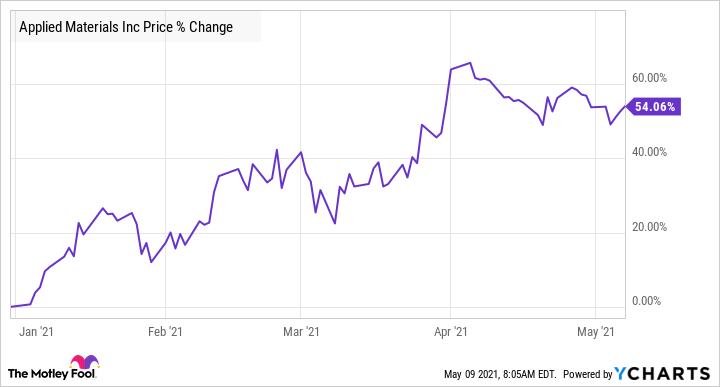The global semiconductor shortage has shown up in a lot of discussions among some companies that have released their earnings reports so far during this season. From smartphone makers such as Apple to semiconductor suppliers such as Cirrus Logic and automakers around the globe, companies are forecasting billions of dollars in lost sales thanks to the limited availability of chips.
A surefire way for an investor to take advantage of this need to resolve a global chip shortage is to buy stock in Applied Materials (AMAT 1.65%) -- a leading supplier of semiconductor manufacturing equipment. The company's stock has been soaring so far in 2021 thanks to a solid quarterly report in February that was accompanied by terrific guidance. Share prices are already up more than 50% since the start of the year, and it wouldn't be surprising to see them double by the end of 2021 thanks to secular growth drivers.
AMAT data by YCharts
Applied Materials upcoming fiscal second-quarter results (scheduled for release on May 20) are likely to act as a catalyst for strengthening the company's stock market rally. Let's take a look at why.
Applied Materials could deliver blowout numbers once again
Applied Materials forecast robust growth in Q2 revenue and earnings, according to the guidance issued in February. The company expects non-GAAP earnings to jump 70% year over year to $1.50 per share on revenue of growth of 36% to $5.39 billion. For comparison, Applied Materials' revenue had increased 24% year over year in the first quarter, while earnings per share had jumped nearly 42% to $1.39 per share.
Applied Materials has switched into a higher gear and Wall Street expects that momentum to continue. Analysts expect the company to deliver $1.55 per share in earnings on revenue of $5.53 billion in the current quarter that has just begun. Applied Materials had delivered $4.4 billion in revenue and earnings of $1.06 per share in the year-ago quarter.
However, the semiconductor equipment market's outlook indicates that Applied Materials' rapid pace of growth is set to last beyond just one or two quarters.

Image source: Getty Images.
Don't miss the big picture
According to the World Fab Forecast report by industry association SEMI, spending on semiconductor fabrication equipment is on track to increase in 2021 and 2022 following last year's substantial gains. The association estimates that fab equipment spending was up 16% in 2020, and it estimates a similar jump of 15.5% this year. For 2022, SEMI estimates fab equipment spending to jump another 12.2%.
It is worth noting that most of this growth will take place in the foundry and the memory segments. More specifically, SEMI estimates foundry spending to jump 23% this year to $32 billion. Spending on memory manufacturing equipment is expected to record a single-digit increase to $28 billion, followed by a 26% spike in 2022.
This bodes well for Applied Materials, as it gets most of its revenue from the semiconductor systems business that caters to these segments. Semiconductor systems revenue had jumped 26% year over year in Q1 to $3.55 billion, accounting for nearly 69% of the company's total revenue.
Not surprisingly, Applied Materials' top line is expected to jump 26% in fiscal 2021, which would be a nice improvement over the 18% annual growth it clocked last year. Applied Materials' management had pointed out on the February earnings conference call that the company expects to "grow faster than the market for the year as a whole." So, the company could replicate its impressive growth next year, as the broader market is expected to grow in the double digits once again.
All of this could ensure that Applied Materials sustains its hot stock market rally in the coming months and ends the year on a high, possibly doubling in value like last year. That should be a good enough reason for investors looking to buy a growth stock to buy Applied Materials, especially considering that it is trading at less than 20 times forward earnings as compared to a trailing price-to-earnings ratio of 32.





